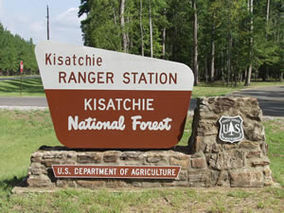
The Kisatchie National Forest holds the remains of the first humans in Louisiana.
Gloria Church sat hunched over a small white basin, gently rubbing a small shard of stone with a toothbrush. Church, a senior anthropology student at the University of Louisiana Lafayette, focused as she cleaned the ancient rock, unearthed during a recent archaeological dig in the Kisatchie National Forest. Archaeologists have been gingerly digging up the ground at the Vernon Parish site, sifting through dirt to unearth and preserve evidence of prehistoric occupation of the area. Most of the artifacts they have found, including stone tools and spearpoints, have been in the ground for millennia. But recent storms and thefts have proven to be a formidable threat. “Between the looting and the hurricane damage we were really in danger of losing this site over time,” U.S. Forest Service archaeologist Matthew Helmer said during a tour in June.
Nola.com
Hurricanes exposed the site.
The site was found by surveyors in 2003, according to the Forest Service. After hurricanes Laura and Delta uprooted trees and exposed some of the artifacts in 2020, Kisatchie National Forest officials decided to use hurricane relief money to begin salvage excavations. The dig uncovered tens of thousands of artifacts, the oldest of which stretch back to Louisiana’s earliest human inhabitants. In addition to Helmer, the project is being overseen by archaeologist John Mayer and Mark Rees, director of UL’s Public Archaeology Lab. “One of the really pressing questions that I’m interested in is, when were the first people in Louisiana,” said Rees. The excavation turned up spearpoints with characteristic notching and design that put them in what’s known as the San Patrice period, about 12,000 years ago. An earlier survey of the site turned up a piece of a Clovis-culture artifact, which is even older. No other Clovis artifacts have been identified in the recent finds, Rees said. There is also evidence of continual occupation, perhaps owing to the convenient local waterways that supplied necessary resources and acted as highways for travel toward the coast, experts say. “There are all sorts of other questions as well, because we are talking about the end of the last ice age,” Rees said. The climate was cooler than it is today, but warming slowly and humans, including those in Louisiana, were adapting, he said.
Sadly people have taken relics for personal use.
Rees laments that the important work being done by archeologists is hampered by people who have conducted unauthorized digs and made off with material from the site. One looter has been convicted in federal court under the Archaeological Resources Protection Act, according to the Forest Service. “It’s like walking into the archive and finding a book that’s so rare it’s one of a kind and it predates writing itself,” Rees said. “It’s like tearing a page out of that book and walking off with it.” In addition to establishing early inhabitation, scientists and archaeologists say they can study stone from the site to see what types inhabitants were using and where the stone might have come from. Other evidence, like signs that postholes were sunk at the site, indicate that structures were possibly built there and people may have lived on the site for longer periods of time. “That’s… a way different lifestyle at that time than we envisioned… than, you know, hunter-gatherers just passing through,” Helmer said.
The findings fit into the narrative as we push back the time of the first humans here.
From a broader perspective, the finds are consistent with others that have steadily pushed back the date of the first human migrations into North America. Now, it is widely accepted that humans likely migrated across the Bering Strait land bridge more than 15,000 years ago. Some groups then migrated down the west coast or on an ice-free corridor inland into what is now the United States, before spreading across the continent. Some Texas sites show evidence of human occupation from 15,000 years ago, Rees said. More excavations and more study could reveal even more, he said. “We could also ask questions about subsistence; What people are doing, how they’re living?” Rees said. “There’s other issues to address.”
We saw the same on Orkney when we visited Scotland. Wave action opened up a site and fortunately the owner knew what he saw and protected it. These people were lucky to live in a National forest so their settlement was protected!
